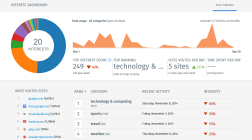The Content Services team is working to reframe how users are understood on the Internet: how content is presented to them, how they can signal what they are interested in, how they can take control of the kinds of adverts they are exposed to. As the Web evolves, these signals will be generated in two places by two actors: in the user’s client, at the user’s behest, or in the cloud, by a service or by a third party who seeks to know whatever it can about the user. We believe it is Mozilla’s place to ensure that the client empowers the user in this relationship and over time, think about how the cloud can play a role.
We’ve been working on an experimental feature that we think is super cool – which we’re calling the “Interest Dashboard” and today, we’ve releasing it as an experimental beta Firefox add-on. The team here is excited about the Interest Dashboard as it explores the advancement of content and the browser. The project has been led under the Product Management of Kevin Ghim and engineering leadership of Ed Lee in the Content Services team. The goal is to see how people consume the Web and try and classify it, and we have something we want to get testing and feedback on with this beta add-on..
How does it work?
You can download the experimental beta Interest Dashboard add-on here.
We believe that there are lots of ways that this add-on can benefit users – from new content discovery, to helping the user manage their own browsing behavior.
The ability to see how that time is spent, on which interests, and at what frequency and volume, will be fascinating for many users. Users will see how their content consumption is categorized and provide feedback directly into the Interest Dashboard. Ultimately, we can then start showing the user a more personalized content experience, on the user’s terms.
We also know that we have a lot of challenges ahead of us. We’d absolutely love your feedback after playing around with the add-on so please leave feedback in Bugzilla or in the comments section of this post. This is a foundational piece for what we’re doing and we have to deliver value for ours users before we build on top of this.
There’s a lot of data science behind the classification system and we’re looking to make it better. The feature presents you with a number of views of your data and actions, but we want to know what you would find interesting.
The Interest Dashboard shows the user their activity and lets them gain insight from it – “what gets measured, gets managed”. In our case, the user of the Interest Dashboard will see all of the user’s browsing behavior and display it in a way the user can interact with. And if you use multiple instances of Firefox, across multiple desktops, or Firefox for Android, and you have connected all instances to a Firefox Account, you will see your data from all your browsing.
The Firefox Interest Dashboard add-on is unique in bringing this functionality directly to the user in their client, under their control. And unlike recommendation engines, the Firefox Interest Dashboard add-on will not be trying to stimulate you to remain engaged with a particular website, it will be a vehicle to allow the user to consciously express their own desires for what they want to browser to do.
So go download the Interest Dashboard add-on and see how much time each month you’re spending on watching kittens or funny videos.

